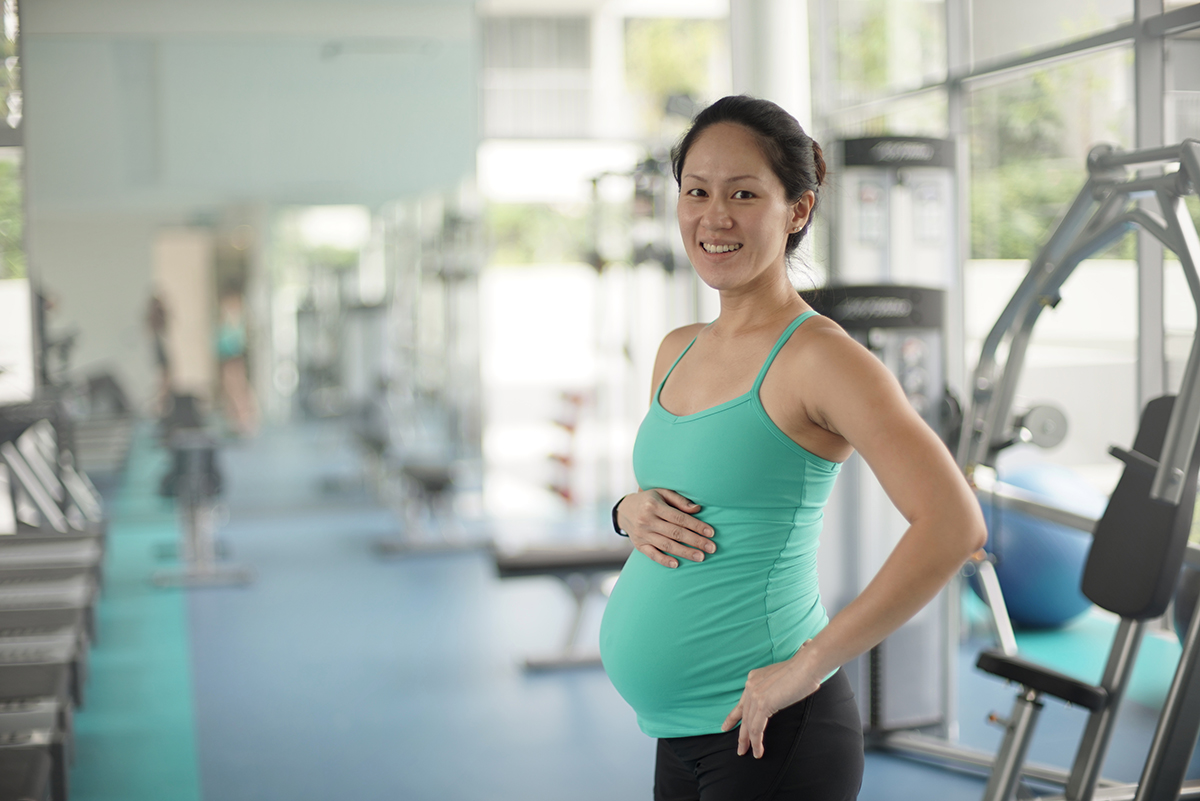Pelvic Floor Dysfunction in Pregnant Women and New Mothers, Preventable & Treatable
Pelvic floor dysfunction, or PFD, is a broad term used to describe several physical conditions that occur mainly as a result from pregnancy and childbirth. As a pre and postnatal fitness specialist for over 20 years, almost every one of my clients has had some form of PFD. What does this mean and why is it relevant to women’s fitness? I will further define PFD in detail and explain how it changes the way we as exercise professionals program design for this clientele.

First, let’s look at the pelvic floor muscles. The pelvic floor looks like a sling or hammock that forms the floor of the bony pelvis and it serves several important functions in our bodies. The internal layer or “pelvic diaphragm” work with the external muscles of the pelvic floor to support our internal organs, stabilize our bodies, allow for sexual function, urinary and bowel movements and assist in contracting and pushing in the birthing process. These muscles are prone to trauma from the various functions they perform. The stress of the growing uterus in the body during pregnancy coupled with the changing gravity, posture and production of the hormone Relaxin all contribute to weakening the pelvic floor muscles.
Second, consider the whole Neuromuscular Core system. Pelvic floor muscles connect to the Transverse Abdominus (TVA) and they work together in harmony essentially hold the body upright. It is almost impossible to engage one without the other. Tightness in the hips combined with weak pelvic floor muscles creates PFD.
Diastasis Recti, Symphosis Pubis Dysfunction (SPD), Urinary and or fecal incontinence, pelvic pain, chronic lower back pain, Piraformis syndrome, sciatic pain, pelvic organ prolapse are all conditions under the pelvic floor dysfunction umbrella. Below these conditions are listed and defined in more detail.
Diastasis Recti: This is a separation of the right and left side of the Rectus Adbdominus in the Linea Alba connective tissue more than 2 cm in width
Pubic Symposis Disorder: A separation of the pubic bones, which often occurs during birth but sometimes during the third trimester.
Urinary incontinence: Uncontrollable leakage from bladder.
Fecal incontinence: Uncontrollable leakage of fecal matter from colon. Usually as a result from severe tearing during birth.
Pelvic pain: This type of pain can be during sex or when performing a movement that is irritating or uncomfortable, many possible underlying issues.
Chronic lower back pain: Unexplainable chronic lower back pain
Sciatica: Pain that radiates from lower back down one leg along the sciatic nerve as a result of compression of the sciatic nerve
Piraformis syndrome: Also a result of an inflamed sciatic nerve but more localized
Pelvic organ prolaps: When organs of the pelvis fall as a result of weak pelvic floor muscles.
These conditions can be limiting for many women and go untreated because they are embarrassed or told that they are normal “experiences” after giving birth. Until recently, very few fitness programs existed to help women strengthen pelvic floor muscles. It is my opinion that every pregnant woman and new mother should be automatically screened for PFD and treated right away. If women do not learn proper strengthening exercises of pelvic floor muscles they can potentially live in discomfort for years. The sooner preventative care is offered the better the quality of life for these women.
As mentioned earlier, many of these conditions are preventable and remedied through a combination of functional strength with corrective, posture-based range of motion exercises. When a woman becomes pregnant there is an immediate increase in pressure to the pelvic floor muscles. The body begins to produce relaxin which affects the joints throughout the body, especially the pelvis as it prepares to accommodate the growing uterus and eventually for birth. If treatment begins to help women continue strengthening the muscles surrounding the hips immediately, the pressure on the pelvic floor muscles will be reduced.
It was common practice until recently that women were advised to learn and perform Kegel Contractions. We understand more now as movement therapists that Kegel contractions are very hard to teach, very isolated, and in most cases, when examined internally by a women’s healthcare PT, women are not performing them correctly. A more effective approach to strengthening the pelvic floor muscles is to treat the entire hip complex as “one”– or a “global approach” — as described in applied functional science.

So, how do fitness professionals help create beneficial, safe and effective exercise programming for pregnant clients and new mothers that hone in on the core and pelvic floor? We must start by helping our clients improve their posture first and foremost, then work on proper breathing techniques and lastly incorporate larger exercises that do not isolate, but recruit many muscles from the hip complex and surrounding muscles groups. By incorporating all three planes of motion instead of working primarily in the sagittal plane (forward and backward) when performing even the most basic of exercises (i.e., the squat), you must change the movement by foot placement, arm placement, direction, tempo, range of motion etc. The variety in actions creates good stress to the pelvic floor and core muscles. Additionally, increasing the adduction and abduction action simultaneously while performing various exercises will help activate and recruit pelvic floor muscles subconsciously. Anatomically speaking, everything is connected in the body. Understanding that big global movements of the upper body and lower body together affect the position and strengthen of pelvic floor and core muscles is essential. The body is most efficient at strengthening the small muscles when big muscle groups are stimulated in combination. Throughout my years, I have seen much success with clients that incorporated these types of movements into their workout regimen and were safe and conscientious not to perform exercises that added bad stress to the external abdominal muscle group or impact exercises.
Each woman is different on how quickly it takes her to recover from PFD. The most important rule of thumb is to be reassuring and provide support and remember the time line is different for everyone depending on severity of PFD, the fitness level of the client, if the client is breast feeding and prior injuries that could prolong healing time.
Online Course for Fit Pros: Prenatal and Postpartum Exercise

Danielle Spangler, C.PT, has been a fitness professional for over 20 years. Danielle is the creator of “Coremom” (Corrective Obstetrical Related Exercises) for purposes of creating a pre and postnatal small group-training program in a variety of fitness facilities. Danielle’s goal is to train other qualified fitness professionals and group exercise instructors on teaching pre and postnatal small group exercise classes using her method. Visit her website, daniellespangler.com



